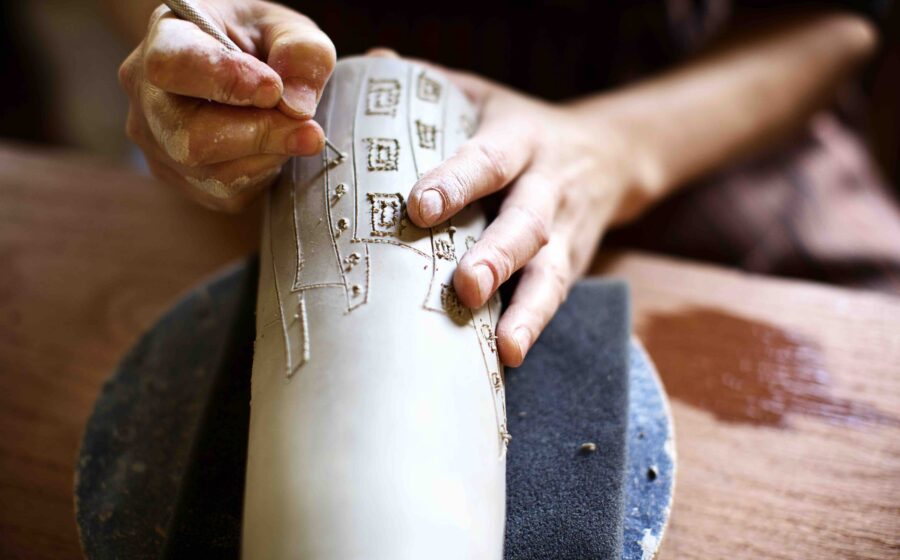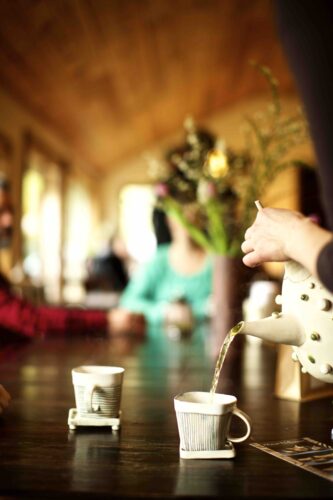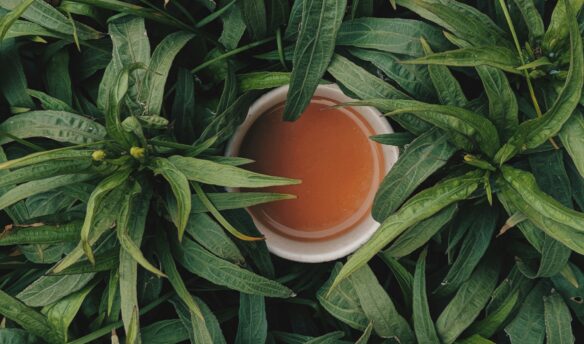[A]dding life to the walls at Teafarm are one-of-a-kind handmade ceramics, crafted by Margit Nellemann on site. The co-owner and -founder of Canada’s first tea farm, featured in Fresh Cup’s May issue, designs items that reflect her love and passion for the beverage. Not just displayed for visitors to admire and purchase, all teas and treats served at the farm are beautifully presented through Margit’s pieces. Plates, cups, platters, and intricate teapots dressed in stripes, polka dots, and cityscape patterns are as important to this home of tea culture in Canada as its leaves. It’s no surprise that the original name for the homestead was Artfarm.
Intricate teapots dressed in stripes, polka dots, and cityscape patterns are as important to this home of tea culture in Canada as its leaves.
Growing up in Fyn, Denmark, Margit’s family was made up of artists. Finding herself connected to their work, she knew deep down that art was part of her future plans. While living and working internationally she explored art, and first began teaching herself clay while living in Spain. After moving to Canada, she decided to devote more time to ceramics.
Functionality is important to Margit’s pieces. It was usefulness, in part, that lead her to teaware. After creating varied teaware for about fifteen years, Margit says her favorite pieces to fashion are teapots. “Teapots are one of the trickiest pieces to create as a ceramist. They are one of the most involved with so much detail and many pieces,” she explains. “I like challenges and this was one of them for me.”
Margit’s work is eye-catching, with vibrant and distinctive characteristics. “I have had some people tell me that they think my teapots look alive or animated. I usually joke that I give them attitude,” she says. Her inspiration is found in many things that surround her. Tea itself is her fuel, and living in the country opens her eyes to the many wonders of nature, recreated in clay. She also enjoys finding inspiration from teaware of different cultures and putting her own signature twist on them. “We have quite a few visitors from around the world and I think they, especially Japanese visitors, appreciate seeing clay being made on site and being different than what they are used to,” she explains. Her popular cityscape teaware designs may seem unusual coming from a rural artist that was also raised on a farm, but Margit relates her work to that of an architect; she sees the teapots as “homes for tea.”
Similar to growing tea, clay work requires patience. In her studio the art of patience is especially tested, as Margit forms clay by hand, using simple tools instead of a pottery wheel. While it is more labor intensive, hand-building allows for more freedom, where perfectly centric pieces could be binding. Allowing the clay to wander into all kinds of directions is what appeals to her most.
You can find Margit in her studio—drinking tea that was grown and processed just feet away—forming clay using two different methods: coil and slab. In the coil method she essentially rolls snakes of clay to build a piece, and with the slab method rolls clay until a desired thickness is reached, then cuts pieces out accordingly. “I create the shape of a piece and then it is more of an intuitive thing. I usually look at what is in front of me, envision and think, ‘that is what it needs to be to continue,’” says Margit.
Tea is an art itself, and Margit’s work is another great connection to the beverage. Hand-building is very slow work and ideally, tea slows an individual and encourages savoring of the moment. For Margit, coiling can be quite Zen, something else she does not think she would experience from using a pottery wheel. The slow process gives her time to think and connect with her medium in a special way. She says the true nature of a piece is also never known until it is out of the kiln. Pieces can push back, crack, or even be ruined entirely. “It is always nice when there is a piece that makes it all the way or even better than I wanted,” she says. Using minimal glazing also allows Margit to appreciate the raw beauty of clay. Exposing the inherent color of the clay, glaze is only used on her pieces for functionality—where mouths will touch and hands will grab. Her functional pieces require a little bit of a Zen experience for users, too. Ideally, they are not intended for the fast, grab-and-go lifestyle. Her art is there to help people enjoy beverages one sip at a time.
As Teafarm evolves, Margit’s goal is to one day have specific teaware associated with their Canadian grown tea. Until then, her next big project will actually not be functional. Recently, Teafarm sacrificed a large maple tree on their property because it was taking too much water from the tea plants. Left with a huge stump, Margit will build a giant teapot to perch there, another piece of marvelous décor for the farm. “Creating beautiful vessels for a beautiful beverage is what I’m here to do,” she says.
—Lu Ann is a tea blogger and marketing consultant based in Ontario, Canada. Read her May feature on Canada’s Teafarm. Photos by Nik West.



















